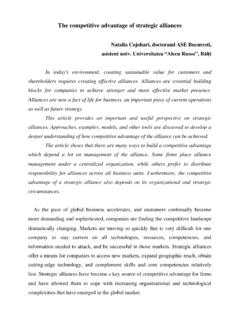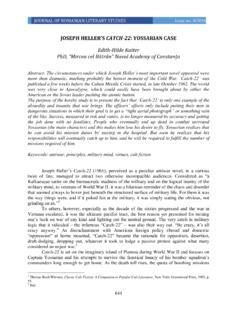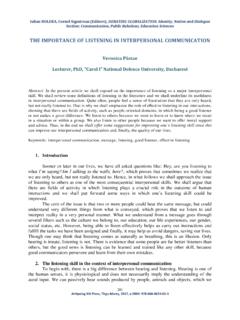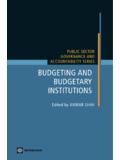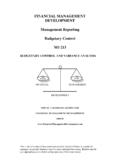Transcription of ASPECTS REGARDING THE INTERNAL CONTROL …
1 CCI3 ECONOMY AND MANAGEMENT 541 ASPECTS REGARDING THE INTERNAL CONTROL ON THE LEVEL OF PUBLIC ENTITIES IN ROMANIA Gabriela Ignat, Assist. Prof., PhD, George Ungureanu, University of Agricultural Sciences and Veterinary Medicine, Ia i Abstract: INTERNAL CONTROL has become a vital integral part of the modern management system. That is why the managers of public entities have to adopt an entire array of measures concerning the organization and management of their activities, which in fact represents implementing their own system of INTERNAL CONTROL . In Romania, INTERNAL CONTROL represents the ensemble of the forms of CONTROL exercised at the level of the public entity, including INTERNAL audit, established by the management according to their objectives and the legal framework.
2 According to the International Audit Standards, INTERNAL CONTROL is defined as the process which is conceived, implemented and maintained by the persons commissioned with management, leadership and other personnel categories with the purpose of delivering a reasonable assurance REGARDING fulfilling the objectives of an entity as far as the credibility of financial statements and the efficiency of the operations are concerned, as well as their conformity to applicable laws and rules.. In the present paper the authors have tried to pinpoint the importance of INTERNAL CONTROL in public institutions. Keywords: INTERNAL CONTROL , audit, management, international audit standards, management CONTROL .
3 Introduction Semantically speaking, CONTROL means a permanent or periodical analysis of an activity or of a situation, in order to observe its course and be able to take the necessary measures for improvement . At the same time, CONTROL signifies a continuous moral and material surveillance, as well as mastering a certain activity or situation. However, in the specialty literature there are more definitions of CONTROL : - In the French-speaking countries, CONTROL represents carefully checking or inspecting the correctness of an act; - In Anglo-Saxon frameworks, CONTROL means the activity of observing an individual or a thing, a minute examination done with the purpose of knowing or improving the functionality of a mechanism.
4 Within the Romanian legal framework, INTERNAL CONTROL is defined as being the assembly of all forms of CONTROL exercised at the level of public entity, including INTERNAL audit, established by the management in accord with its objectives and the legal provisions, in order to ensure the management of public funds in an economic and efficient manner; this also includes the organizational structures, methods and procedures. According to the International Audit Standards, issued by the International Auditing and Assurance Standards Board (IAASB) of the International Federation of Accountants CCI3 ECONOMY AND MANAGEMENT 542 (IFAC), INTERNAL CONTROL is defined as being the process conceived, implemented and maintained by those charged with governance, management and other categories of personnel with the purpose of providing reasonable REGARDING the fulfillment of the objectives of an entity REGARDING the credibility of financial reporting, the efficiency of operations and the conformity with applicable laws and regulations.
5 Material and method The present paper is the result of the careful processing of information gathered after having taken into consideration a series of works acknowledged as relevant for the chosen topic, as well as the careful examination of the regulations REGARDING INTERNAL CONTROL at the level of public entities Results and discussions The notion of INTERNAL CONTROL is understood differently in various European countries. While in some countries there are specialized institutions for INTERNAL CONTROL , independent from those controlled, in other countries the responsibility of INTERNAL CONTROL falls upon the respective administrative entities. Some countries have a system of INTERNAL CONTROL integrated within the system of governance.
6 The need to establish INTERNAL CONTROL , to report on it and to apply an approach on managing the risk can be formulated distinctively in laws and regulations, or it could derive from an existing legal framework. Within decentralized systems, the managers in top management have the duty to report on the functionality of INTERNAL CONTROL systems. More and more countries demand from such managers the application of management systems that can diminish the risk of not fulfilling the established objectives. In Luxembourg and Spain, the notion of INTERNAL CONTROL is regarded as being the whole public administration CONTROL system and the sum of all institutions taking part in the management of public funds.
7 These countries also have specific CONTROL organisms, like Intervenci n General de la Administraci n del Estado (IGAE) in Spain or Inspection G n rale des Finances in Luxembourg, which are independent from the authorities and entities that they CONTROL , economically and financially. Especially in countries like Denmark, the Netherlands, Sweden or the United Kingdom, the public INTERNAL CONTROL system is understood as the conceptually comprehensive approach harmonized by the government to ensure the establishment, maintenance and monitoring by the managers of all public entities of all integrated management processes. In these countries, INTERNAL CONTROL has the goal of managing risks and supplies a reasonable insurance REGARDING the meeting of general objectives, while following the entity s mission.
8 These objectives refer to the adequate execution, ethically, economically and efficiently, of activities; liability obligations; conforming to the applicable laws and regulations; protecting the sources that need not be wasted, but adequately used, without being deteriorated. In France and Portugal, where there once were powerful instutions specialized in CONTROL , one has begun to decentralize the ex ante CONTROL in particular, and through this to increase the responsibility and accountability of public managers. INTERNAL financial and accounting CONTROL of the entity is to be applied in order to ensure the accounting management and a financial monitoring of the company s actions, so that the defined goals can be achieved.
9 This CONTROL has in view the assembly of process for CCI3 ECONOMY AND MANAGEMENT 543 obtaining and communicating accounting and financial information and contributes to the delivery of coherent information, in conformity with the legal provisions. Through CONTROL , the public entity ensures the dynamic information, real and preventive, that raises the value and quality of decisions. The main models of CONTROL , recognized internationally, conceived in order to organize the INTERNAL CONTROL system so that it corresponds to the demands of management are: the COSO model in the US and the COCO model in Canada. Comparing the two models for INTERNAL CONTROL one can draw the following conclusions: a) According to the COCO model, INTERNAL CONTROL is a process implemented by all the employees of an entity and has a relative character, offering a satisfactory assurance REGARDING the fulfilment of objectives.
10 B) According to the COCO model, INTERNAL CONTROL places a stronger focus on the means implemented than on employees, without offering absolute assurance that it helps to reach objectives . In order to promote efficient management, in the public sector one implements the public INTERNAL financial CONTROL , which includes the management/ INTERNAL CONTROL system, INTERNAL audit, coordination and centralized harmonization of all components. Public INTERNAL CONTROL has always existed in all countries, and lately it has been developed as a concept recognized and used on a large scale, reaching the status of a basic element of the modern management system. In the European Union we find the following forms of public INTERNAL CONTROL : The French public administration has a long tradition of public-affairs CONTROL , notably based on the principles of the Declaration of the Rights of Man17 and enshrined in the Constitution18, which is also reflected in the legal rules set out, for instance, in general and specific civil service regulations and in the Public Procurement Contracts Code.

